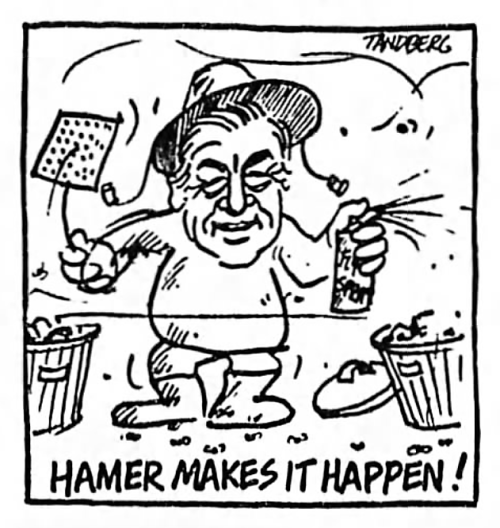The Australian-English phrase the (great) Australian salute designates the movement of the hand in brushing away flies.
The earliest occurrence of the phrase that I have found is from Flies ‘menace to tourist industry’, published in The Age (Melbourne, Victoria) of Wednesday 3rd May 1967:
Canberra.—Flies menaced the Australian tourist industry, and the CSIRO 1 should be given every encouragement to combat them, Mr. Chaney (Lib., WA) 2 said yesterday.
He told the House of Representatives that important people arriving at Canberra airport always gave “the Australian salute”—waving the flies away.
1 CSIRO is the abbreviation of Commonwealth Scientific and Industrial Research Organization.
2 The Australian politician Frederick Chaney (1914-2001) represented Perth, in Western Australia, at the Australian House of Representatives from 1955 to 1969.
These are the exact words uttered by Chaney, according to The Canberra Times (Canberra, Australian Capital Territory) of Thursday 4th May 1967:
“Anybody who watches on television the arrival at Canberra Airport in summer months of an important personage from overseas will see him or her giving the great Australian salute—waving the flies away from the face.”
The following is from It’s war, so swot up on your fly swats, the title of ND column, by John Stevens, published in The Age (Melbourne, Victoria) of Tuesday 19th August 1975:
In what at first sight may seem a futile and Quixotic gesture, the State Government is about to wage war on the fly.
Most would say straight off that there isn’t a set of politicians in the land who would be a match for the aggression and muscle of the good old Aussie fly.
But to make the numbers more even, Coach Hamer 3 plans to throw in the public service, so the outcome could be a near-run thing after all.
After more than a year of planning, the Premier’s Fly Suppression Committee—a name for any musca domestica to conjure with—is poised to strike.
[…]
The two main fly pests are the house fly and the bush fly. They look almost identical but the bush fly is the fly of Australian legend, the one that swarms all over your skin in the sunshine, seeking moisture, the one that inspired the “Australian salute”.
3 The Australian politician Rupert Hamer (1916-2004) served as the 39th Premier of Victoria from 1972 to 1981.
This cartoon by Tandberg illustrated It’s war, so swot up on your fly swats, published in The Age (Melbourne, Victoria) of Tuesday 19th August 1975:
HAMER MAKES IT HAPPEN!
The following advertisement is from the column The Shop Detective, by Jay Butler, published in The Sydney Morning Herald (Sydney, New South Wales) of Tuesday 4th November 1975:
Enjoy Summer Without Flies!
You see it on the beaches. You see it on the streets. The Great Australian Salute: the almost unconscious brushing away of flies that has become a trademark of the Australian summer. And now there’s an end to the Great Australian Salute. Announcing new Tabard—the personal insect repellant in a handy stick. You simply apply it in strokes like a stick of frozen cologne. No oily spray, no waste. New Tabard smells good and feels cool. It can be applied easily to children. And, most important of all, it works! New Tabard—now available at most supermarkets, Chemists and Shell Service Stations.
There exist two variants of the phrase:
1-: The Queensland salute. The following is from the Sunday Mail (Brisbane, Queensland) of Sunday 30th August 1981—as quoted in A Dictionary of Australian Colloquialisms (Sydney University Press in association with Oxford University Press Australia, 1990), by Gerald Alfred Wilkes (1927-2020):
The flies stick to you, and you suddenly realise what they mean when they talk about the Queensland salute.
2-: The Barcoo salute 4. This is first recorded in The Barcoo Salute (Adelaide: Rigby, 1973), the title of an account by the Australian author Patsy Adam-Smith (1926-2001) of her travels around Australia.
This book derives its title from the following conversation, which appears on the title page, and is—according to the review published in The Sun-Herald (Sydney, New South Wales) of Sunday 16th December 1973—dated 1954:
“I see you’ve learnt the Barcoo Salute,” said a Buln Buln Shire 5 Councillor to the Duke of Edinburgh.
“What’s that?” said His Royal Highness, waving his hands again to brush the flies off his face.
“That’s it,” said the man from the bush.
4 The Barcoo salute is named after the Barcoo River, in western Queensland. This river has also given its name to several diseases, such as Barcoo vomit (also Barcoo sickness, Barcoo spews) and Barcoo rot (denoting a skin ulceration similar to scurvy).
5 The Shire of Buln Buln was a local government area in the state of Victoria.

